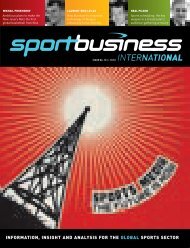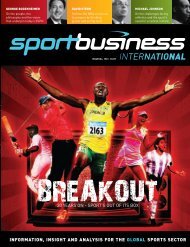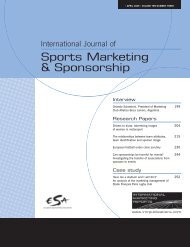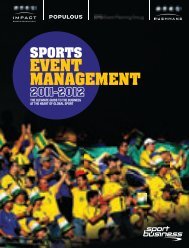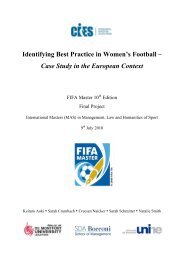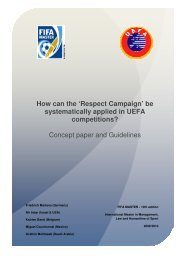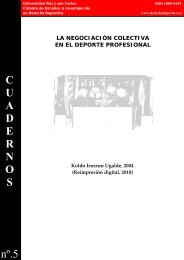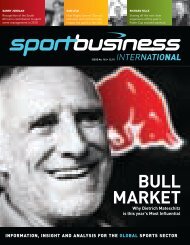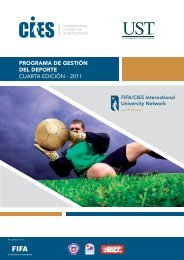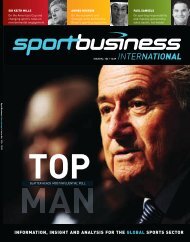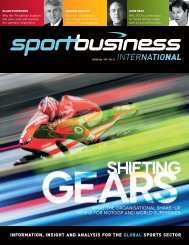Sports Marketing & Sponsorship - FIFA/CIES International University ...
Sports Marketing & Sponsorship - FIFA/CIES International University ...
Sports Marketing & Sponsorship - FIFA/CIES International University ...
- No tags were found...
You also want an ePaper? Increase the reach of your titles
YUMPU automatically turns print PDFs into web optimized ePapers that Google loves.
Causal effectsfollowed by environmental attribute and technicalattribute. In other words, the PSQ is determined by afan’s evaluation of a total of service dimensions, ofwhich some are technical, some are functional andsome are environmental in nature (Grönroos, 1984).In relation to the causal relationship between PSQand satisfaction, our findings were equivalent to thetheoretical position of the causal sequence of PSQ andsatisfaction that has held a dominant position in theliterature as well as having the most empiricalvalidation (e.g. Cronin & Taylor, 1992; Anderson &Fornell, 1994; Gotlieb et al, 1994; Rust & Oliver,1994; Brady & Robertson, 2001). Lazarus’ (1991)theoretical framework of appraisal-emotional responsecopingcould also interpret the nature of therelationship between PSQ and satisfaction in this study.According to his theoretical framework, consumers arelikely to make an appraisal which is the cognitiveevaluation of service quality, and it drives a first andforemost emotive satisfaction assessment. Thus, PSQcould function as a determinant of satisfaction basedon its cognitive orientation in the case of MiLB. Inother words, spectator satisfaction could be influencedby the presence of a pre-established service qualityperception (Bolton & Drew, 1991).The findings of this study lead to somerecommendations for sports marketers in MiLB. First,sports marketers are continually competing with otherentertainment options for fans and spectators.Understanding all aspects of the spectator experience atan event is important. All experiences, from parking toconcessions to the event itself, play a role in aspectator’s decision about whether to return to a venue.Second, sports marketers should keep utilising thequality of the home team, a rival team or playersduring the season in order to attract and retain morefans at their events (Howat et al, 1996), even if thequality of team performances is beyond their control.<strong>Sports</strong> fans are often affected by the core product,which could be the quality of the home team, the rivalteam or individual players.Third, sports marketers should pay more attention toselecting, training and matching employees to servicedelivery (Grot & Dye, 1999). They do have controlover functional quality and not just in the area ofpromotions. The first interaction a consumer may havewhen attending an event is with a parking attendant.A negative experience there can often lead to anegative perception of the team and thus theorganisation. <strong>Sports</strong> marketers, while not directlyinvolved with this aspect of an event, should ensurethat employees are properly trained and provide apositive experience for consumers. This is also true forticket office employees and others.Fourth, sports marketers also have control and inputin the environmental area of service quality (Wakefield& Blodgett, 1999). Making sure the environment isconducive to a positive experience is important, frommaking sure seats are in good condition, to thepositioning of handrails, to making sure toilet facilitiesare in good order.Finally, since a spectator’s cognitive judgment ofservice quality plays an antecedent role in influencingthe affective evaluation of a service encounter inMiLB, sports marketers should consider PSQ as ameans of improving satisfaction judgments and makeefforts to develop strategies that facilitate andstrengthen positive satisfaction assessments (Brady &Robertson, 2001). This systematic approach couldenhance spectators’ behavioural intentions inattending MiLB.The research shows these areas of service qualityhave a direct influence on perception of servicequality. <strong>Sports</strong> marketers must take advantage of thisinformation and use it to provide positive servicequality experiences and thus increase spectatorsatisfaction.Limitations and future studiesThis study exhibits a few limitations that should beconsidered for future studies. First and foremost, itmay be limited because the sample was confined toone league in MiLB. Even if the findings from therelationships among the latent constructs wereconsistent with previous studies, it is limited in itsability to apply to other spectator sports. FutureRESEARCH PAPER● OCTOBER 2009 ● <strong>International</strong> Journal of <strong>Sports</strong> <strong>Marketing</strong> & <strong>Sponsorship</strong>55



